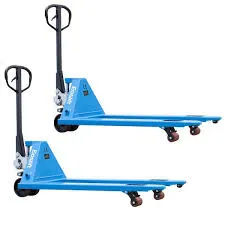


Understanding Pallet Truck Dimensions A Comprehensive Guide
Pallet trucks, also known as pallet jacks, are essential tools in warehouses, factories, and retail environments, facilitating the movement of goods stored on pallets. When selecting the right pallet truck for your operations, understanding its dimensions becomes crucial. This article explores the various dimensions of pallet trucks, their significance, and how they influence your material handling capabilities.
1. Key Dimensions to Consider
a. Overall Length The overall length of a pallet truck generally includes the forks and the frame. This dimension is fundamental as it determines how the pallet truck will interact with pallets of varying sizes. Standard pallet trucks often have a length of around 1200 mm (47.2 inches), which fits most common European pallets, known as Euro pallets. However, specialized pallet trucks are available for handling larger or smaller pallets.
b. Fork Length The fork length typically ranges from 1000 mm (39 inches) to 1200 mm (47.2 inches). Longer forks are ideal for moving larger pallets or handling multiple pallets simultaneously. Conversely, shorter forks may be more maneuverable in tight spaces, making them suitable for retail environments or small warehouses. Choosing the right fork length is vital for efficient loading and unloading.
c. Fork Width Standard fork width varies between 150 mm (5.9 inches) and 200 mm (7.9 inches), but custom widths are available for specific applications. The width affects the truck’s ability to fit under pallets and its overall stability. A wider fork can provide better weight distribution, which is particularly important when transporting heavy loads.
d. Height of the Forks The height of the forks when in the lowest position is often around 75 mm (2.95 inches). This dimension is critical for ensuring that the pallet truck can easily slide under pallets without obstruction, making it efficient for low-profile pallets or spaces.
e. Maximum Lift Height Most pallet trucks can lift to a height of 200 mm (7.87 inches) to 205 mm (8.07 inches), which is sufficient for standard pallet operations. For operations requiring the transport of goods to racks or shelves, consider a pallet truck with higher lift capabilities or a stacker.

2. Importance of Choosing the Right Dimensions
Selecting a pallet truck that fits your operational needs is crucial for productivity. Improperly sized pallet trucks can lead to inefficiencies, such as difficulty maneuvering in tight spaces or the inability to handle certain types of pallets. Furthermore, using the wrong truck can result in damage to your goods or, worse, accidents in the workplace.
3. Impact on Efficiency and Safety
The right pallet truck dimensions not only enhance operational efficiency but also bolster safety. An ideal pallet truck should allow workers to move goods easily without straining or risking injury. A well-sized truck improves navigation through aisles and around obstacles, lowering the likelihood of accidents. Moreover, proper fork dimensions contribute to load stability, reducing the risk of spills or drops.
4. Customization Options
Many manufacturers offer customizable dimensions, allowing businesses to tailor pallet trucks to their specific needs. Whether requiring longer forks for large items, narrower widths for congested areas, or higher lift heights, customization can lead to significant improvements in logistics and handling efficiency.
Conclusion
Understanding pallet truck dimensions is indispensable for optimizing material handling processes in your organization. By considering the key dimensions—overall length, fork length, fork width, height of the forks, and maximum lift height—you can select the pallet truck best suited to your operational requirements. Making an informed choice enhances efficiency, promotes safety, and ultimately contributes to smoother warehouse operations. Always consult with suppliers and assess your specific needs before acquiring new material handling equipment. Implementing the right pallet truck can be a game changer in how you manage and move your inventory.



